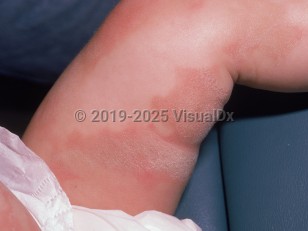Erythrokeratodermia variabilis in Adult
Alerts and Notices
Important News & Links
Synopsis

Erythrokeratodermia variabilis (EKV) is a rare, worldwide genetic skin disorder within a heterogeneous group of erythrokeratodermas. It is also known as Mendes da Costa syndrome. Over 200 cases have been reported, usually with an autosomal dominant inheritance pattern. EKV is caused by mutations of GJB3, GJB4, and GJA1 genes which encode connexins 31, 30.3, and 43, respectively. Connexins are constituents of the intercellular channels called gap junctions.
EKV is characterized by stable hyperkeratosis and transient erythematous patches. Typically, one feature predominates, and sometimes one can be absent. Over half of patients present with migratory patches of erythema at or soon after birth, and 90% within the first year of life. These lesions typically are most prominent in childhood and slowly subside toward adulthood.
Transient erythematous patches demonstrate marked variability in location, size, number, duration, and shape. Individual patches last minutes to weeks and may be exacerbated by trauma, stress, or temperature change. Hyperkeratosis tends to occur with or follow the development of erythematous patches and can be localized or generalized in distribution. Fixed patches of erythema with or without hyperkeratosis also occur. Half of patients have a peeling palmoplantar keratoderma. The disorder progresses through childhood, stabilizes after puberty, and may regress as the patient moves into adulthood.
Worsening of both types of lesions has been seen with temperature changes, sun exposure, pregnancy, and oral contraceptive use. Health is otherwise normal. The patient may complain of burning, stinging, or itching.
EKV is characterized by stable hyperkeratosis and transient erythematous patches. Typically, one feature predominates, and sometimes one can be absent. Over half of patients present with migratory patches of erythema at or soon after birth, and 90% within the first year of life. These lesions typically are most prominent in childhood and slowly subside toward adulthood.
Transient erythematous patches demonstrate marked variability in location, size, number, duration, and shape. Individual patches last minutes to weeks and may be exacerbated by trauma, stress, or temperature change. Hyperkeratosis tends to occur with or follow the development of erythematous patches and can be localized or generalized in distribution. Fixed patches of erythema with or without hyperkeratosis also occur. Half of patients have a peeling palmoplantar keratoderma. The disorder progresses through childhood, stabilizes after puberty, and may regress as the patient moves into adulthood.
Worsening of both types of lesions has been seen with temperature changes, sun exposure, pregnancy, and oral contraceptive use. Health is otherwise normal. The patient may complain of burning, stinging, or itching.
Codes
ICD10CM:
L53.8 – Other specified erythematous conditions
SNOMEDCT:
70041004 – Erythrokeratodermia variabilis
L53.8 – Other specified erythematous conditions
SNOMEDCT:
70041004 – Erythrokeratodermia variabilis
Look For
Subscription Required
Diagnostic Pearls
Subscription Required
Differential Diagnosis & Pitfalls

To perform a comparison, select diagnoses from the classic differential
Subscription Required
Best Tests
Subscription Required
Management Pearls
Subscription Required
Therapy
Subscription Required
References
Subscription Required
Last Reviewed:05/26/2021
Last Updated:01/16/2022
Last Updated:01/16/2022
Erythrokeratodermia variabilis in Adult

